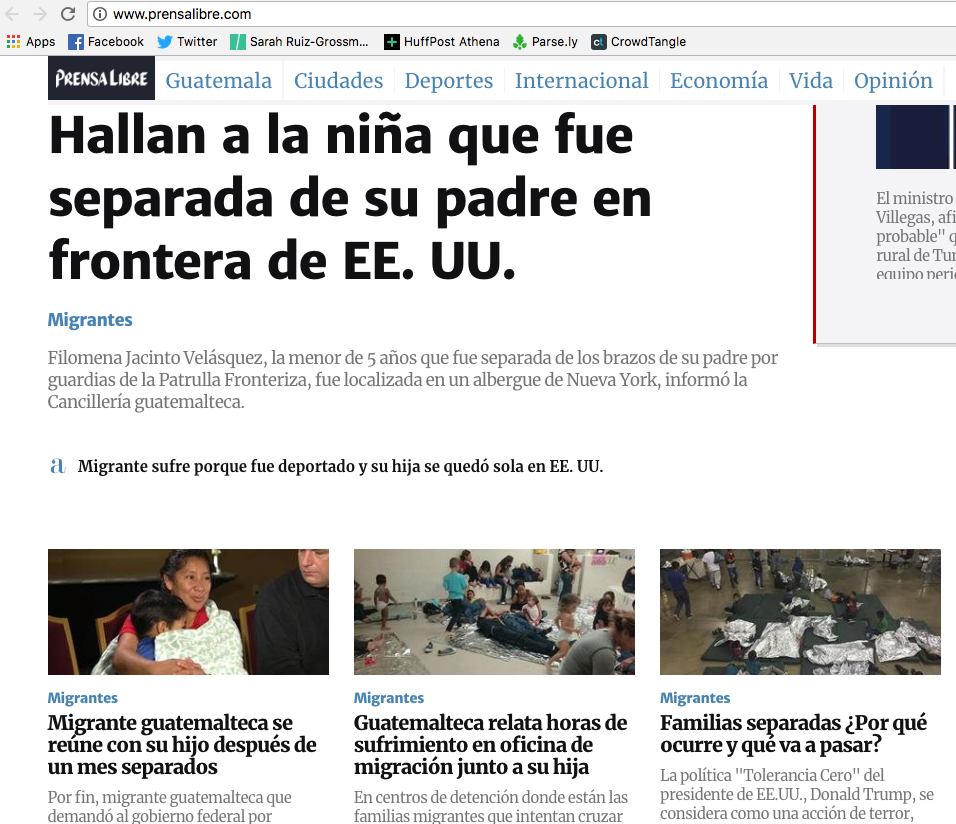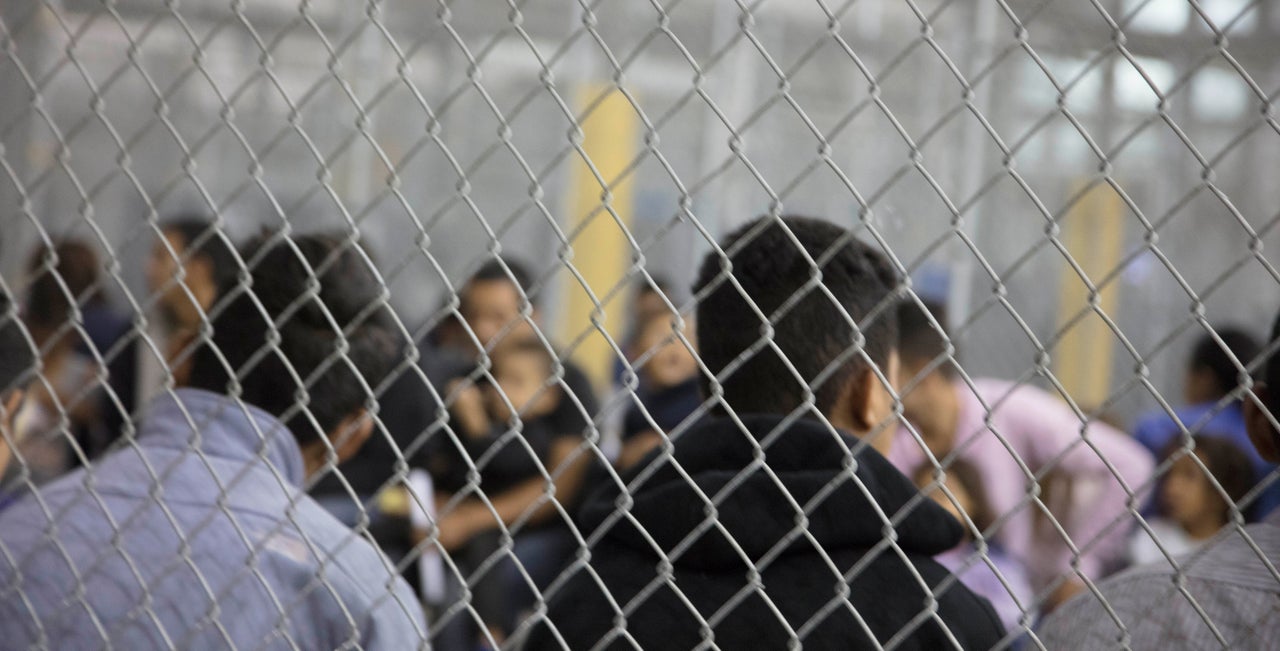Despite the Trump administration’s harsh immigration policies aimed at deterring migrants from coming to the U.S., it’s likely that no amount of news of the border crackdown will stop migrants from Central America ― many of whom are fleeing desperate situations of poverty and violence ― from making the trek north.
The front pages of newspapers in Guatemala, Honduras and El Salvador ― where increasing numbers of migrants crossing into the U.S. are from ― have been plastered with reports of President Donald Trump’s zero tolerance unauthorized immigration policy and its devastating effects on families in the past couple of weeks.
Two days after he signed an executive order effectively halting immigrant family separations in favor of indefinite family detentions ― the website of Prensa Libre, one of the main Guatemalan news outlets, featured four stories of U.S. immigration at the top of its front page.
“They found the girl separated from her father at the U.S. border,” one headline read. “A Guatemalan woman recounts hours of suffering at immigration offices with her daughter,” read another. “Separated families: Why is it happening and what’s next?” read a third.
“People are aware of what’s happening. They’re reading the news, listening to the radio, looking at the web on their cellphones,” Héctor Silva, a senior researcher at Insight Crime ― a research group focused on security and crime in Latin America ― told HuffPost by phone from El Salvador. “So they are conveying the message, ‘Listen, it’s getting harder.’”
“But is that deterring people from migrating? My answer is no,” he added, noting that he has spoken to recent arrivals in the U.S. “They’re saying, ‘Everything is better than what we left back there.’”

“If you look at the reasons why families, children, women are fleeing in the first place, I don’t think it is going to impact the decisions of those fleeing violence in their own communities,” said Adriana Beltrán of WOLA ― a human rights research and advocacy group focused on Central America. She said many migrants come from communities “either under the control of street gangs or where you have a strong presence of organized crime.”
“In those circumstances, despite what they hear, they’re going to continue looking for safety,” she added.
The countries of Central America’s Northern Triangle ― El Salvador, Guatemala and Honduras ― have been plagued by poverty, violence, political crises and government corruption. The number of immigrants in the United States from those countries increased by 25 percent from 2007 to 2015, according to Pew Research. In a survey of immigrants from the region, respondents said they were fleeing high homicide rates, gang activity and other violence, as well as seeking economic opportunity and joining relatives already in the United States.
Despite a decline in Honduras’ murder rate, it remains among the worst in the world for peacetime nations. Last year Honduran security forces shot and killed at least 16 people protesting after its elections, according to the United Nations. El Salvador has one of the highest homicide rates in the world and a serious gang violence problem, including from MS-13, which started in Los Angeles. And in Guatemala nearly 1 in 10 residents lives below the poverty line of less than $2 a day, according to World Bank data from 2014.
“As hard as it may get, as many barriers as they try to put, if here people can’t find ways to get out of poverty, no matter the barriers, they’ll keep trying.”
- Sergio Morales, reporter with Guatemala’s Prensa Libre
Even for migrants who may not be following the latest developments on U.S. immigration policy ― many in Guatemala come from poorer, rural regions with less access to news ― many will likely still get word of harsh treatment at the border from those who recently traveled the routes north or from relatives they have in the U.S.
“That’s just yet another horror in the list,” Silva said of family separations and detentions.
For any migrant, the possibility of deportation or abuse on arrival ― not to mention the risks of violence from coyotes, or smugglers, along the way ― has always been part of what Silva called the “risk kit” when people make the hard choice to leave their home behind.
He said that for Central Americans, the U.S. government’s animosity toward migrants is nothing new, noting the high rate of deportations under the Obama administration and reports of abuses in Immigration and Customs Enforcement detention centers that go back years.
However, there is a new intensity to the Trump administration’s treatment, he said, particularly given the anti-immigrant rhetoric coming from nation’s highest office.
“It’s sending a new message,” Silva said, pointing out the less widely discussed but equally devastating new policy of restricting asylum access for victims of gang violence.
“Definitely this guy doesn’t like us ― people of our origins, of our color,” he added.

Migrant numbers have always ebbed and flowed, depending on conditions in the countries of origin and at the U.S. border. But as long as the government corruption and insecurity from violence in the Northern Triangle ― which Silva called “so rooted and hopeless” ― doesn’t change, “people will keep going north,” he said.
As it gets harder to enter the U.S, some migrants may choose to pursue asylum in Mexico instead, said Amanda Hernández Moreno, a reporter with El Salvador’s La Prensa Gráfica.
Even if the U.S. government’s harsh reception affects the flow of migrants, it will likely be for only a couple of months, said Sergio Morales, a reporter at Guatemala’s Prensa Libre.
“As hard as it may get, as many barriers as they try to put, if here people can’t find ways to get out of poverty ― no matter the barriers ― they’ll keep trying,” he said.
One Prensa Libre column on Friday echoed this sentiment, with the headline “Bad there and worse here.” The author, Jorge Jacobs, wrote not of the threat of gang violence but of poverty.
“The reason is simple: because here they didn’t have the opportunities to get by for themselves or their families,” he wrote. “I guarantee you that most would rather live in their own country, their hometown, if there were ways to make a living with dignity. But unfortunately, there aren’t.”
Migrants who have recently crossed into the U.S. ― some of whom were detained and separated from their children ― have echoed that message for the media in recent days.
“If they separate us, they separate us,” 41-year-old Luis Cruz, a migrant from Guatemala at a shelter in Tucson, Arizona, told The New York Times last week. He left behind his wife and four of his kids, taking one child with him. “But return to Guatemala? This is something my son cannot do.”
